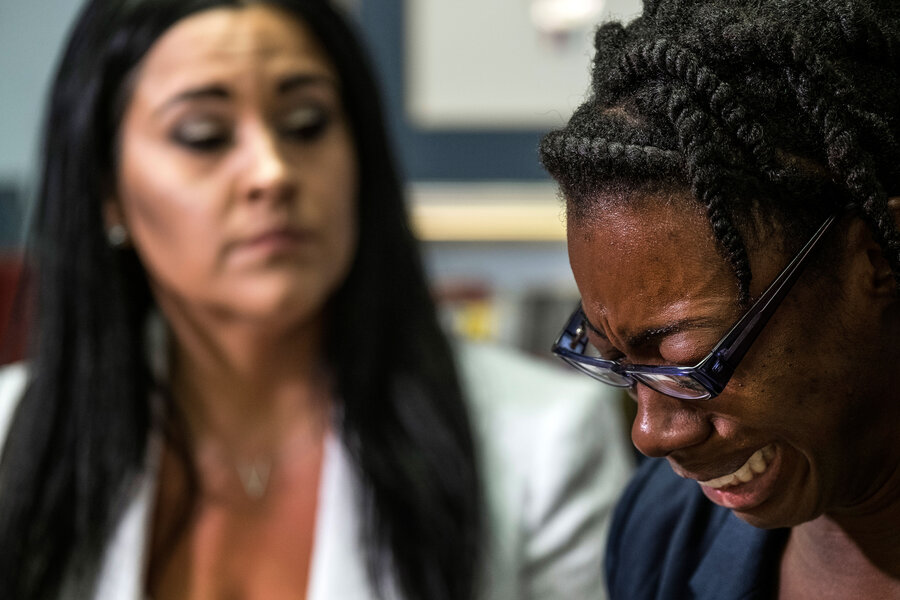Austin cop's reference to blacks' 'violent tendencies' strikes an old chord
Loading...
A video surfaced this week of two Austin police officers yanking second grade school teacher Breaion King from her car at a routine traffic stop and then violently throwing her to the ground twice.
Austin Police Chief Art Acevedo apologized to Ms. King for the way she was treated by Officer Bryan Richter at a press conference Thursday.
“You were approached in a manner and treated in a manner that is not consistent with the expectations of this police chief, of most of the officers of this police department, and most importantly, I think, of all of us as human beings,” said Chief Acevedo.
The video's release comes at a time when police around the United States are under heightened scrutiny for what many critics say is a national pattern of disproportionately aggressive policing of members of the black community. A conversation between the arresting officer and his colleague included in the video suggests a prejudicial view of African-Americans as inherently threatening.
Officer Richter first pursued King after he saw her going 50 miles per hour in an area with a 35 m.p.h. speed limit. King later pulled over in a Wendy’s parking lot and got out of the car. The dash cam video shows Richter asking King to get back in the car and to find her driver’s license.
King doesn’t close her car door, and Richter said she continued to be “uncooperative.” She later pulled away from him while reaching for something on the passenger side of the vehicle, and Richter tried to grab her arms. King then tried to throw a punch “so I took her to the ground,” Richter said in his police report.
A second video shows King sitting in the backseat of the patrol car talking to Richter and Officer Patrick Spradlin, who had joined his colleague at the scene.
In this conversation, Officer Spradlin says people are likely afraid of black people because of “violent tendencies.”
“99 percent of the time you hear about stuff like that it is the black community being violent,” adds Spradlin.
Individual officers have been accused of harboring similar sentiments in other high-profile arrests and shootings of black suspects.
Ferguson, Mo., police officer Darren Wilson came under fire in 2014 for the way he described the unarmed teenager Michael Brown during a grand jury hearing convened to determine whether Officer Wilson should face indictment for Mr. Brown's death earlier that year, as The Christian Science Monitor's Patrik Jonsson reported at the time:
Some of his characterizations of the incident have raised red flags among experts who study race and policing.
For example, Wilson describes Mr. Brown as looking like a rage-filled “demon” as he geared up to charge the officer. Wilson said that he felt like a kid trying to wrestle Hulk Hogan during their altercation, despite being roughly the same height as Brown. And he characterized Canfield Drive, where Brown was shot, as an area “hostile” to police, meaning his guard was already up when he approached Brown about a stolen box of cigarillos.
The broader question for policing is not necessarily one of overt racism, rather it is a question of whether unexamined perceptions of black people and black neighborhoods creep into the so-called use-of-force matrix an officer turns to in times of crisis. In a country where black people are up to 21 times more likely to be shot by police than whites, according to a ProPublica analysis of FBI statistics, the issue is of enormous importance, experts say.
Back in Austin, King's attorney Erica Grigg, who is white, says she sees clear bias in the officer's treatment of her client.
“I was heartbroken because I looked at that video and thought that would never happen to me as a white woman,” King’s attorney Erica Grigg told KXAN News. “It’s what I believe; I don’t think it would’ve escalated the way it did had she been white.”
The incident happened in June 2015, but Ms. Grigg says her client was afraid to go forward with the case until now.
“She was just so embarrassed and horrified and scared quite frankly to come forward and complain," Grigg said. "She doesn’t trust the police any more after this and so I think that’s what took her so long to come forward.”
King says she eventually decided to come forward to set an example for her students.
“What happened to me was inexcusable and the individual officers who violated my rights, and the public trust, must be held accountable in our courts of law,” she said in a statement. “The violence we have recently seen against the men and women who serve us in uniform is also deplorable.”
Just this week, the shooting of an unarmed black man in North Miami Monday also caused nationwide outrage. As The Monitor’s Lucy Schouten reports:
Police were called while Charles Kinsey, a caretaker at a group home for the disabled, was working to calm a man diagnosed with autism who had run away and sat in the street, blocking traffic. Mr. Kinsey lay down in the street with his hands up, trying to negotiate with both anxious police and his patient, but an officer shot three times, hitting him once in the leg, according to The Miami Herald.
'The straw that really breaks the camel’s back, that makes it even more frustrating, is that after my client was shot, they handcuffed him and left him on the hot Miami summer pavement for 20 minutes while fire rescue came and while he was bleeding out,' Kinsey’s attorney Hilton Napoleon told The Washington Post, saying he hoped to negotiate a settlement with the police department.






